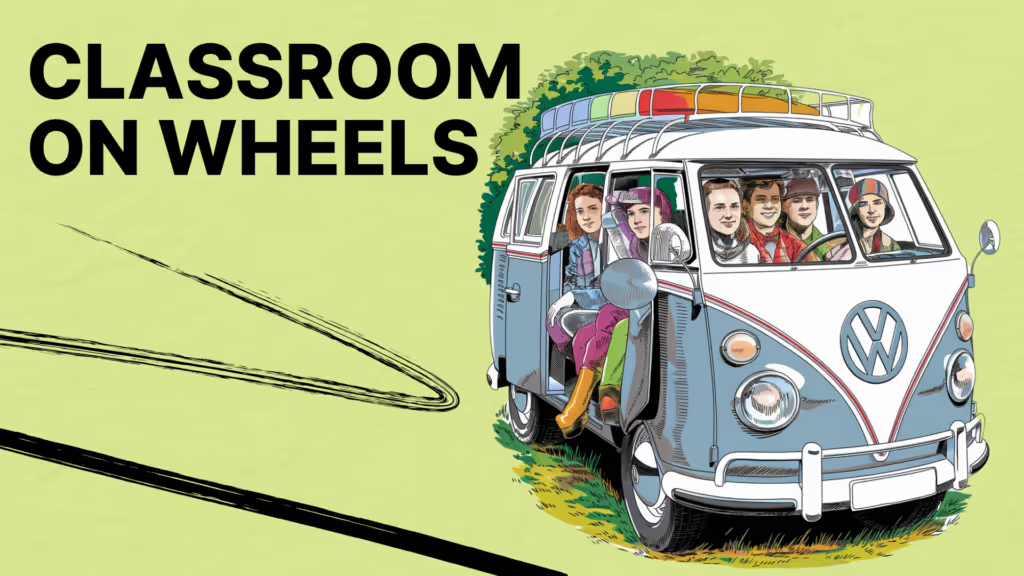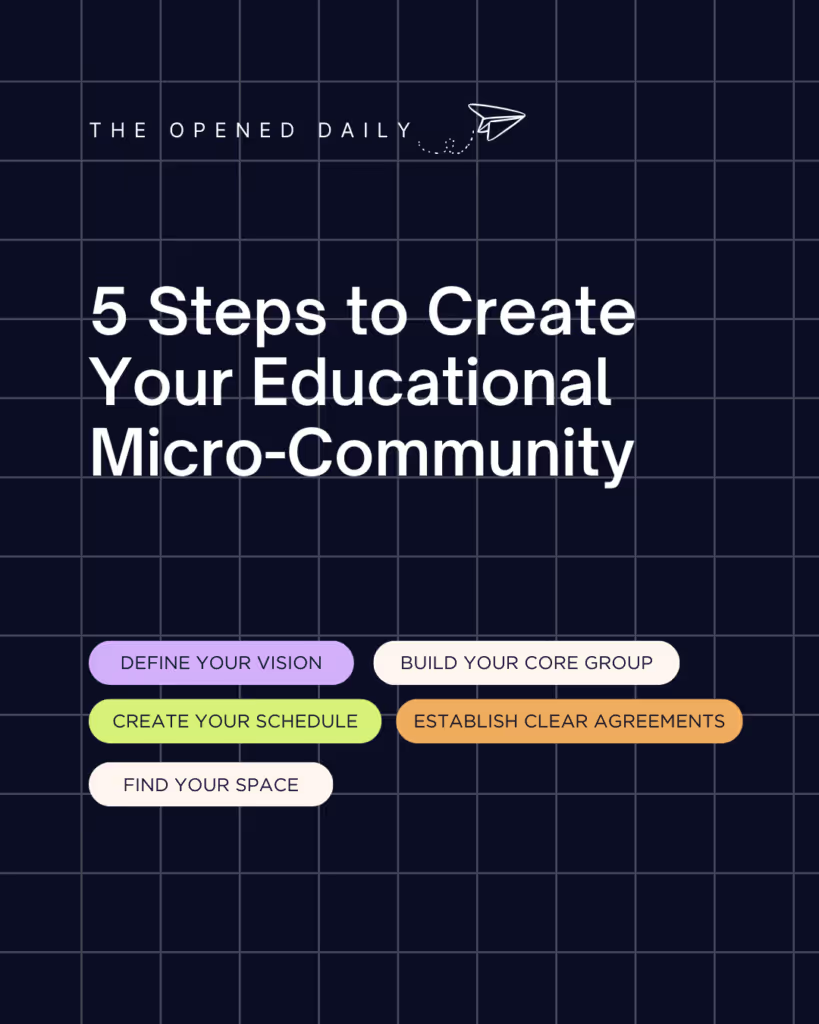
How to Create a Thriving Educational Micro-Community: The Complete Guide | Eleyah Knight
How to Create a Thriving Educational Micro-Community: The Complete Guide | Eleyah Knight
How to Create a Thriving Educational Micro-Community: The Complete Guide | Eleyah Knight
When Eleyah Knight purchased a 14-passenger van in September 2023, she wasn't just buying transportation—she was reimagining what "school" could be.
"I'm going to make this an adventure school," she decided, creating a mobile learning environment for teens.
No fixed classroom, no rigid schedules—just a group of curious young people, one passionate educator, and a world of possibilities that extended far beyond four walls.
"I decided to make this like a real-life skill-building opportunity for teens between 12 and 18," Eleyah told me during our recent conversation. Her mobile microschool "Connected Teens" now offers cooking and nutrition on Mondays, coding and theater on Tuesdays, and field trips with guest teachers on Fridays.
While my first thought was "wow, that's a lot of miles on the odometer," my second was "this woman is onto something brilliant."
Indeed, Eleyah's story represents a massive shift happening in education across America. According to the National School Choice Awareness Foundation, interest in microschooling and hybrid learning options has skyrocketed by an astonishing 220% in just the past year—far outpacing growth in traditional schooling models and even homeschooling (which itself saw a respectable 39% increase).
But here's the good news: you don't need to buy a passenger van or quit your day job to create meaningful educational experiences for your children. Many families are finding the sweet spot in educational micro-communities—small groups of learners coming together regularly for shared learning experiences that supplement whatever other education they're receiving.
Think of it as the educational equivalent of a potluck dinner. Everyone brings something to the table, nobody has to cook the entire meal, and somehow the combination turns out more delicious, nutritious, and memorable than anything you could have prepared alone.
- What Makes Educational Micro-Communities So Powerful?
- Different Types of Educational Micro-Communities
- The Secret to Student Engagement: Real-World Learning
- Finding Your Community: Where to Connect with Like-Minded Families
- Organizations Making Micro-Communities Easier Than Ever
- Step-by-Step Guide to Starting Your Own Micro-Community
- Conclusion: Your First Step
What Makes Educational Micro-Communities So Powerful?
Educational micro-communities are small groups of learners (typically 5-15 students) who gather regularly for collaborative learning experiences. Unlike traditional classrooms with 25+ students, these intimate groups create environments where children feel truly seen and supported.
Eleyah Knight discovered what she considers the "magic number" for these communities: 8-12 students.
"The small group setting has been transformative," she explained. "It becomes like a family and builds deep trust. We establish clear agreements at the beginning of the year and before new units, setting explicit expectations for each other."
This isn't just warm fuzzy talk. A recent meta-study by the Small Schools Coalition confirms that "smaller, more intimate learning communities consistently deliver better results in academics and discipline when compared to their larger counterparts" and create stronger relationships among students, educators, and parents.
The effectiveness of these micro-communities comes from personalized attention, deeper peer relationships, and the ability to adapt quickly to student interests. Perhaps most importantly, in these small groups, everyone has a voice—even the kid who would rather die than raise their hand in a classroom of 30 peers.
"I've seen them develop a strong sense of identity and confidence naturally,” Eleyah observed about her students, “without the overwhelming influence of media, political agendas, or the intense peer pressure you find in traditional schools with hundreds or thousands of students."
In these smaller settings, educators can truly see and respond to each child as an individual with unique gifts, challenges, and interests. The magic happens in that personal connection.
Different Types of Educational Micro-Communities
Not all micro-communities look alike—thank goodness, because if they did, we'd just be recreating the same cookie-cutter approach we're trying to escape. Here are the most common models you might consider:
Homeschool Co-ops and Learning Pods form when homeschooling families pool their talents and resources, typically meeting 1-3 days per week. Dalena Wallace, founder of Wichita Innovative Schools and Educators (WISE), started this way: "Three families became five, then ten, then a co-op with 16 families," she recalls. "We had some other friends who found out what we were doing and were like, 'You're doing classes in your home? This is great. Can we join you?'" These groups often emphasize social connections and enrichment activities that complement home learning.
Part-time Microschools offer more structured programs with designated teachers or facilitators, often following a specific educational philosophy like Montessori, Waldorf, or Acton. They typically meet 2-4 days per week and provide core academic instruction while allowing for family time and flexibility.
Mobile and Adventure-Based Groups prioritize learning through community exploration and real-world experiences, similar to Eleyah's van-based model. These dynamic programs use the community as a classroom and focus on experiential learning, community connections, and practical skills. As Eleyah puts it: "We get out in the community and learn what's going on, and see different career options.”
Specialized Interest Communities form around specific passions that traditional schools might only touch on briefly. Surf Skate Science in South Florida teaches physics and biology through surfing and skateboarding. Students study marine life, skateboard design, engineering of concrete, and the physics of waves—all while thinking they're just having fun at the beach.
Nature schools and forest kindergartens represent another growing specialized approach, where children spend 80-90% of their time outdoors (regardless of weather, in the case of Nature Kids Connect). These programs integrate science, observation skills, and resilience through direct interaction with the natural world.
Breakout School, designed specifically for students with ADHD and autism, uses this nature-immersion approach to great effect. As founder Dal Richardson reports, students who previously hated school develop a newfound love of learning when allowed to move freely, take breaks as needed, and connect their studies to the world around them.
The Secret to Student Engagement: Real-World Learning
If you've ever tried to explain to a 10-year-old why they need to learn fractions while they stare at you with the enthusiasm of someone awaiting a root canal, you'll appreciate this insight from Eleyah:
"The key to any sort of learning is how do you make it more interesting? How do you make it more applicable?" she explained. "The student needs to see how they're going to use it. Otherwise, they're going to ask, 'What is the point?'"
This disconnection explains why so many students struggle with traditional subjects. When math is just numbers on a worksheet, many students shut down. But when those same numbers help them build something real—like the garden beds Eleyah's students were constructing—suddenly math makes sense.
The same principle applies to writing, which many students resist until they can connect it to their interests: "When they get to deliver their own story, or do an investigation, or write about something they're passionate about or think is funny—humor is a huge way to get through to teens—suddenly they engage differently."
This approach is backed by research. The Center for Engaged Learning notes that well-designed learning communities emphasizing collaborative, contextual learning result in improved academic performance, higher retention, and increased student satisfaction.
In micro-communities, this real-world connection happens naturally through project-based learning, community engagement, and student-led inquiries. As Eleyah summarizes: "You can cover every subject they cover in public school, but do it in your own unique way with the resources available to you and with what's relevant in the modern world that you live in."
Or as I like to put it: when learning actually matters, suddenly it actually matters.
Finding Your Community: Where to Connect with Like-Minded Families
Before you can create an educational micro-community, you need to find your people. Here's where to look:
Online Communities have made finding like-minded families easier than ever. Search Facebook Groups for terms like "homeschool co-op," "learning pod," or "microschool" plus your location. Specialized platforms like SchoolHouse and LearningPodsHub connect families interested in forming learning pods. Subscribe to newsletters from organizations like Alliance for Self-Directed Education and National Microschooling Center for opportunities and connections.
Kerry McDonald's LiberatED podcast is another invaluable resource featuring interviews with educational innovators and practical advice for creating alternative learning environments to understand what approaches you're drawn towards.
Local Community Resources often hide in plain sight. Libraries host homeschool meetups, parks and recreation programs attract families open to alternative education, and museums and nature centers draw families interested in hands-on learning. Never underestimate the power of simply talking to other parents at the playground about your educational ideas—you might be surprised who shares your vision.
Finally, regional networks like Dalena Wallace's WISE network in Wichita provide directories of creative schools, meeting opportunities, and mentorship connections for local families. Check if something similar exists in your area.
Organizations Making Micro-Communities Easier Than Ever
Starting an educational alternative used to mean building everything from scratch, but today, several organizations provide robust support systems for families and educators. Here's how they're transforming the landscape:
Prenda has become one of the largest microschool networks in the United States, supporting K-8 microschools of 5-10 students. They provide a complete curriculum, a microschool management platform, and even financial services to help with the business side. As their website explains: "We provide inspiring adults with the structure and support needed to empower young learners." For families in states with Education Savings Accounts (ESAs) like Arizona, Florida, and Arkansas, Prenda can help navigate funding options that make microschooling accessible at minimal out-of-pocket cost.
Primer takes a different approach, focusing on helping educators launch their own microschools through their Leader Fellowship program. They handle all the regulatory approvals, leasing, and campus operations while providing a proprietary software platform called PrimerOS.Their fellowship even includes a monthly stipend during the launch phase, followed by a competitive salary when your microschool opens.
Omella addresses the practical side of running a microschool with a platform specifically designed for administrative tasks. Their system helps microschools "efficiently manage their tuition, forms, and waivers" with customizable payment plans, digital forms, and secure collection systems. This allows microschool founders to focus on teaching rather than paperwork.
Acton Academy provides a well-developed model emphasizing self-directed learning and real-world skills. Their approach views each child as a "hero" on a personal journey, blending Montessori principles with Socratic dialogue to cultivate autonomous learners. With hundreds of locations worldwide, they offer a proven model for those whose educational philosophy aligns with their mission.
Wildflower Schools supports teacher-led Montessori microschools that emphasize child-centered learning in intimate settings. Their network focuses on creating beautiful, peaceful learning environments where children can follow their natural development.
These established networks can provide valuable structure and guidance as you begin your journey—significantly reducing the barriers to creating meaningful educational alternatives. Of course, if you have your own vision and want to “go it alone,” you don’t have to follow any of these models

Step-by-Step Guide to Starting Your Own Micro-Community
Ready to create your own educational micro-community? Here's how to get started without losing your mind:
Step 1: Define Your Vision and Purpose
Before inviting others to join you, get clear on your own educational values and goals. What gaps are you trying to fill? How structured or flexible do you want the experience to be? What educational philosophy speaks to you most?
Eleyah's clarity about her "why" has been crucial to her success: "I decided to create a real-life skill-building opportunity for teens, a way they can get out in the community and learn what's going on, see different career options, as well as participate in what I'm best at."
Write down your vision, purpose, and non-negotiable values as a foundation for everything that follows. If you can't explain it clearly on paper, you'll have a hard time explaining it clearly to potential participants—and a really hard time staying true to it when challenges arise.
Step 2: Build Your Core Group
Start with a small group of committed families who share your vision. Begin with 1-5 families you already know and trust, host an informal information session to share your vision, and be upfront about expectations for participation and contribution.
Look for complementary skills and resources among founding families. Maybe one parent is a math whiz, another loves literature, and a third has a perfect space for gathering. The beauty of micro-communities is that you can leverage everyone's strengths rather than expecting every parent to excel at teaching everything.
Dalena Wallace's experience reflects this organic growth approach: "We had some other friends who would find out what we were doing, and they were like, 'You're doing some classes in your home. This is great. Can we join you?'"
Begin with a trial period (4-6 weeks) to test your approach, schedule regular check-ins with participating families, and be open to feedback. Document what works well and what needs improvement, and gradually expand programming as you build confidence.
The beauty of starting small is that you can adjust course without disrupting a massive operation. Think of your first few months as a beta test—you're gathering data about what works for your specific combination of children, parents, and educational goals.
Step 3: Create Your Structure and Schedule
Design a framework that balances structure with flexibility. Determine how often you'll meet, create a consistent calendar that works for core families, and clarify who will lead different components.
Eleyah emphasizes the importance of balancing structure with flexibility: "It's crucial to provide structure so they know what to expect. But equally important is flexibility. You need both: structure so they know what's coming, but also the ability to adapt when things change."
Her program follows a consistent weekly pattern—Mondays for cooking and nutrition, Tuesdays for coding and theater, Fridays for field trips—but within that structure, there's room for following student interests and adapting to opportunities that arise.
Step 4: Establish Clear Agreements
Create explicit agreements to prevent misunderstandings and conflicts. How will children be expected to participate? What contributions are required from each family? How will costs be shared? How will the group make decisions?
Eleyah highlights the importance of these agreements: "We establish clear class agreements at the beginning of the year and before new units, setting explicit expectations for each other. If issues arise, we have the framework to communicate clearly and ensure everyone feels comfortable and heard."
Document these agreements in writing and review them regularly with all participants. It's much easier to discuss expectations before you're in the middle of a disagreement.
Step 5: Find Your Space
You don't need a formal classroom to create powerful learning experiences. Many successful micro-communities begin in family homes, rotating between different houses to share the responsibility. Others use community spaces like library meeting rooms, park pavilions, or church auxiliary rooms.
Dalena Wallace notes: "To me, I feel like starting in homes is the easiest, most simplified, most cost-effective way to do that. But it's not gonna be for everybody because you talk to those founders and they're like, 'I want my space back.'"
For those thinking bigger, Wallace offers an intriguing possibility: repurposing abandoned shopping malls as educational hubs. "You have a different class in each store... and the food court, you have all your options there, and it's just like your education. You have all your schools to choose from, take a class à la carte here and there." Mall education—coming soon to a failing retail center near you!
Conclusion: Your First Step
What begins as a small group of families learning together can grow into something truly transformative—not just for your children, but potentially for education itself.
Eleyah Knight's vision exemplifies this expansive thinking: "I have this vision that's going to become reality soon enough: sailing around the world with teens on a ship where we grow food below deck and raise animals, starting up farm schools in every country we visit."
While you might not be planning to circumnavigate the globe with a shipful of teenagers (and honestly, who could blame you?), your micro-community can still have profound impact. Start with a simple weekly gathering around a kitchen table. Focus on making learning real and relevant. Build relationships that support every child's growth.
Educational micro-communities represent the leading edge of a fundamental shift in how we approach learning—moving away from standardized, one-size-fits-all models toward personalized, community-based environments where children can truly flourish.
You don't have to wait for someone else to create the perfect educational environment for your child. The power to shape your child's educational journey is in your hands—and in the hands of the community you build around them.
The future of education isn't closed and standardized—it's open, diverse, and full of possibility. Your micro-community might just be the beginning of something extraordinary. And it definitely doesn't require a 14-passenger van...unless, of course, you want it to.
Are you ready to take the next step in your family's educational journey? Join our community of open education families and get personalized support for your unique situation. Sign up for our newsletter to receive weekly tips, curriculum recommendations, and encouragement for your homeschooling journey.
Subscribe to The OpenEd Daily
Join 20,000+ families receiving curated content to support personalized learning, every school day.
.webp)
.avif)


.png)
.png)
